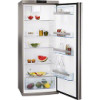AEG DynamicAir Freestanding 59.5cm Refrigerator Stainless Steel S63300KDX0 Pro - Page 10
Troubleshooting
 |
View all AEG DynamicAir Freestanding 59.5cm Refrigerator Stainless Steel S63300KDX0 manuals
Add to My Manuals
Save this manual to your list of manuals |
Page 10 highlights
10 www.aeg.com This appliance contains hydrocarbons in its cooling unit; maintenance and recharging must therefore only be carried out by authorized technicians. 6.2 Periodic cleaning The equipment has to be cleaned regularly: • clean the inside and accessories with lukewarm water and some neutral soap. • regularly check the door seals and wipe clean to ensure they are clean and free from debris. • rinse and dry thoroughly. Do not pull, move or damage any pipes and/or cables inside the cabinet. Never use detergents, abrasive powders, highly perfumed cleaning products or wax polishes to clean the interior as this will damage the surface and leave a strong odour. Clean the condenser (black grill) and the compressor at the back of the appliance with a brush. This operation will improve the performance of the appliance and save electricity consumption. Take care of not to damage the cooling system. Many proprietary kitchen surface cleaners contain chemicals that can attack/ damage the plastics used in this appliance. For this reason it is recommended that the outer casing of this appliance is only cleaned with warm water with a little washing-up liquid added. After cleaning, reconnect the equipment to the mains supply. 6.3 Defrosting the refrigerator Frost is automatically eliminated from the evaporator of the refrigerator compartment every time the motor compressor stops, during normal use. The defrost water drains out through a drain hole into a special container at the back of the appliance, over the motor compressor, where it evaporates. It is important to periodically clean the defrost water drain hole in the middle of the refrigerator compartment channel to prevent the water overflowing and dripping onto the food inside. Use the special cleaner provided, which you will find already inserted into the drain hole. 7. TROUBLESHOOTING During operation of the appliance some smaller but annoying trouble can often occur, which does not require calling a technician out. In the following chart in- formation is given about them to avoid unnecessary charges on service.















